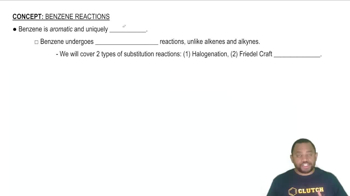Consider the formate ion, HCO2-, which is the anion formed when formic acid loses an H+ ion. The H and the two O atoms are bonded to the central C atom. (b) Are resonance structures needed to describe the structure?
Ch.8 - Basic Concepts of Chemical Bonding
Chapter 8, Problem 60
Which of the following statements about benzene, C6H6, is or are true?
i. Benzene has two equivalent resonance structures.
ii. There are no nonbonding pairs in the Lewis structure for benzene.
iii. Benzene has three short and three long C—C bonds.
 Verified step by step guidance
Verified step by step guidance1
Identify the molecular structure of benzene, \( \text{C}_6\text{H}_6 \), which is a planar ring with alternating double and single bonds.
Understand that benzene is best represented by resonance structures, which are two equivalent structures where the double bonds are in different positions.
Recognize that in the resonance hybrid of benzene, all C—C bonds are of equal length due to the delocalization of electrons, contradicting statement iii.
Examine the Lewis structure of benzene to confirm that there are no nonbonding electron pairs on the carbon atoms, supporting statement ii.
Conclude that statements i and ii are true, while statement iii is false, based on the equal bond lengths in benzene.

Verified video answer for a similar problem:
This video solution was recommended by our tutors as helpful for the problem above.
Video duration:
4mWas this helpful?
Key Concepts
Here are the essential concepts you must grasp in order to answer the question correctly.
Resonance Structures
Resonance structures are different ways of drawing the same molecule that illustrate the delocalization of electrons. In the case of benzene, C6H6, it has multiple resonance structures that contribute to its overall stability. However, these structures are not equivalent in terms of energy; rather, they represent the same molecule's electron distribution, leading to the concept of resonance hybrid.
Recommended video:
Guided course

Resonance Structures
Lewis Structure
A Lewis structure is a diagram that represents the bonding between atoms in a molecule and the lone pairs of electrons that may exist. For benzene, the Lewis structure shows alternating single and double bonds between carbon atoms, but it is important to note that there are no nonbonding pairs of electrons on the carbon atoms, as all valence electrons are involved in bonding.
Recommended video:
Guided course

Lewis Dot Structures: Ions
Bond Lengths in Benzene
Benzene exhibits a unique bonding situation where all carbon-carbon bonds are of equal length due to resonance. This results in bond lengths that are intermediate between single (C—C) and double (C=C) bonds, leading to the conclusion that benzene has six equivalent C—C bonds, rather than three short and three long bonds. This equal bond length is a key characteristic of aromatic compounds.
Recommended video:
Guided course

Benzene Reactions
Related Practice
Textbook Question
Textbook Question
Predict the ordering, from shortest to longest, of the bond lengths in CO, CO2, and CO32- .
Textbook Question
Consider a Lewis structure for SO3 that satisfies the octet rule. Which of the following statements is or are true?
i. SO3 has three equivalent resonance structures.
ii. There are one shorter and two longer S—O bond lengths in SO3.
iii. The S atom in SO3 has a nonzero formal charge.
Textbook Question
b. Which of these compounds or ions is an exception to the octet rule: nitrogen dioxide, borohydride (BH4−), borazine (B3N3H6 which is analogous to benzene with alternating B and N in the ring), or boron trichloride?
